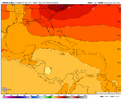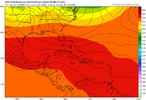BHS1975
Member
That's a weird place for a stall.
That's a weird place for a stall.
I think there are many of us who wish this system would spread some of those heavier precipitation totals further north towards the Southeast and the Deep South.


The 0Z UKMET once again has just a rather weak low (not even a TC on the textual output; it has yet to show TCG in the Caribbean on this output though it awhile back had several runs with TCG east of the Lesser Antilles) and again into Nicaragua. The last 5 runs have shown a weak low either hitting Nicaragua (0Z 10/19, 12Z 10/18), barely E of Nic. but heading into it (0Z 10/18, 12Z 10/17), or still 200 miles E of Nic. but likely headed into it (0Z 10/17).
Looking at the H5 vorticity, it appears that as the AOI on the TWO comes into the E Car that a portion of it turns sharply right like the GFS but unlike that model it never develops. Then what looks like a split from this, possibly incorporating additional vorticity coming off northern S America, causes the weak low to move into the SW Caribbean, which then goes into Nicaragua.
So, the UKMET remains a SW outlier. I should add that yesterday’s 12Z JMA is similar and it has been similar all of the way back to the 12Z 10/15 run. So, the JMA has had 4 12Z runs in a row with just a weak low into Nicaragua or just offshore headed there.
Thus the UKMET and JMA have a good chance to both either fail badly or end up doing the best of the major operationals with this.
0Z 10/19 UKMET 156:
View attachment 175572
12Z 10/18 JMA 168:
View attachment 175573
ouch. This would not be good for Jamaica
View attachment 175589
ouch. This would not be good for Jamaica
View attachment 175589
You know for all the talk of models sucking this year they really nailed this
Except the GFS that insisted it would go to Hispanola
I’d argue that the UKMET was even worse than the GFS. Remember those runs taking it into Nicaragua and then only slowly correcting northeast? A lot of the blame has to be on it having too weak a system thus causing it to prog a lower mean level of steering, which took it too far SW.
The UKMET is a strange model because it is so hit or miss. It was absolutely stellar with Imelda (even a bit better than the very good Icon) with it never even coming close to landfalling on the SE US. It was also the best with Ian (again Icon was 2nd best) for BOTH US hits: it turned right into SW FL on every run within 4 days out vs others that were too far N until later on and it had the 2nd hit on mid or upper SC on every run within 4 days vs others that took longer to have their first run with a mid to upper SC hit. They were hitting NE FL, GA, and lower SC for a number of runs while UK was CHS north. In other words, the UKMET was furthest right and won.
And then there are others for which UKMET was the worst. When the UKMET is the worst, it’s usually too far left (like for Melissa).
I think I know the formula that might work best. When UKMET is a left outlier, bet against it. But when it is a right outlier, bet on it.
Yes, absolutely elated by 12z trends and praying the Icon scores big.Anyone been noticing that low in the northern gulf this weekend?
That’s why ACE is dumb data. Helps nothing and means nothing.
I don't know, if it doesn't hit land then why would the strength of the season matter. It should be impact driven like tornado ratings.That’s because you’re looking for a strictly impact related index. ACE is quite meaningful and is a great way of counting how much activity there’s been compared to other seasons. It’s a great way to measure the amount of energy being converted from potential to kinetic by the oceans. Impact is irrelevant to it as we know. Actually, an impact usually reduces ACE potential of a particular storm vs if it were to stay OTS.
You mean the Cat rating? We have a good rating system but I just don’t think ACE is needed.I don't know, if it doesn't hit land then why would the strength of the season matter. It should be impact driven like tornado ratings.
I’m far from knowledgeable on the subject but it would seem to me that the ACE would drive weather patterns down the road that are not directly associated with land impacts. Weather patterns and such later down the road that would direct affect land masses.I don't know, if it doesn't hit land then why would the strength of the season matter. It should be impact driven like tornado ratings.
It's too late for this.Has 2 tropical storms, the 2nd headed to FLA. Where was this pattern in AUG/SEPT?
View attachment 177101
Sure it is which is why it's funny the gfs is spitting it out.It's too late for this.
It was at 700 feet and there were hills and mountain tops that likely saw winds over 200mph.The 252 MPH wind gust recorded in Melissa back in October has been officially recognized as the highest wind ever recorded in a hurricane or typhoon by NOAA.
The 252 MPH wind gust recorded in Melissa back in October has been officially recognized as the highest wind ever recorded in a hurricane or typhoon by NOAA.
Here's some of Josh's meteorological analysis from Melissa:
